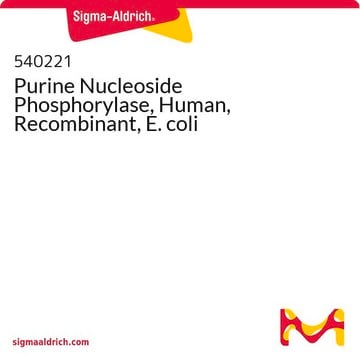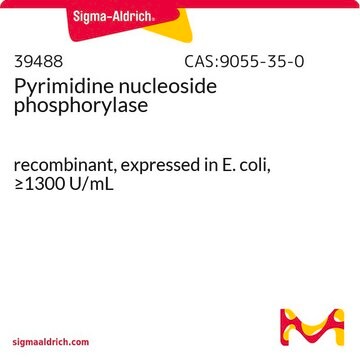40809
Purine nucleoside phosphorylase
recombinant, expressed in E. coli, ≥120 U/mL
Sign Into View Organizational & Contract Pricing
All Photos(1)
About This Item
CAS Number:
MDL number:
UNSPSC Code:
12352204
Recommended Products
recombinant
expressed in E. coli
form
buffered aqueous solution (100 mM phosphate buffer with 1 mM MgCl2)
specific activity
≥120 U/mL
storage temp.
−20°C
InChI
1S/C10H12N4O4/c15-2-6-7(16)8(17)10(18-6)14-4-13-5-1-11-3-12-9(5)14/h1,3-4,6-8,10,15-17H,2H2/t6-,7-,8-,10-/m1/s1
InChI key
MRWXACSTFXYYMV-FDDDBJFASA-N
Looking for similar products? Visit Product Comparison Guide
Application
Purine nucleoside phosphorylase is used to study nucleotide salvage pathways and purine metabolism. It is used to study purine nucleoside phosphorylase deficiency and responsible PNP genetic mutations.
Biochem/physiol Actions
Purine nucleoside phosphorylase is an enzyme involved in purine metabolism. PNP metabolizes adenosine into adenine, inosine into hypoxanthine, and guanosine into guanine. Mutations in the PNP gene are responsible for purine nucleoside phosphorylase deficiency.
Unit Definition
1 U will cause the phosphorolysis 1 μmol of inosine to hypoxanthine and ribose 1-phosphate per minute at pH 7.4 at 25°C
Storage Class Code
12 - Non Combustible Liquids
WGK
WGK 3
Flash Point(F)
Not applicable
Flash Point(C)
Not applicable
Choose from one of the most recent versions:
Already Own This Product?
Find documentation for the products that you have recently purchased in the Document Library.
Purine nucleoside phosphorylase deficiency with a novel PNP gene mutation: a first case report from India
Manisha Rajan Madkaikar, et al.
BMJ Case Reports, DOI:10-DOI:10 (2011)
Fernanda Canduri et al.
Biochemical and biophysical research communications, 313(4), 907-914 (2004-01-07)
Human purine nucleoside phosphorylase (PNP) is a ubiquitous enzyme which plays a key role in the purine salvage pathway, and PNP deficiency in humans leads to an impairment of T-cell function, usually with no apparent effect on B-cell function. PNP
M Palmer et al.
Alimentary pharmacology & therapeutics, 36(4), 370-378 (2012-06-20)
Combination therapy with the ribavirin (RBV) prodrug taribavirin (TBV) and pegylated interferon (PIFN) has produced lower rates of anaemia than with RBV and PIFN. Studies have demonstrated that the sharpest decline in viral load during TBV therapy occurs at Weeks
A M Ledgard et al.
Reproduction, fertility, and development, 24(7), 962-972 (2012-09-01)
The uterus provides the nurturing environment that supports the growth of the early preimplantation bovine conceptus. To determine critical time points of uterine influence, in vitro-produced Day 7 blastocysts were transferred into synchronous (Day 7) uteri and asynchronous uteri (Days
Eric J Sorscher et al.
Cancer chemotherapy and pharmacology, 70(2), 321-329 (2012-07-05)
Systemically administered fludarabine phosphate (F-araAMP) slows growth of human tumor xenografts that express Escherichia coli purine nucleoside phosphorylase (PNP). However, this treatment has been limited by the amount of F-araAMP that can be administered in vivo. The current study was
Our team of scientists has experience in all areas of research including Life Science, Material Science, Chemical Synthesis, Chromatography, Analytical and many others.
Contact Technical Service








